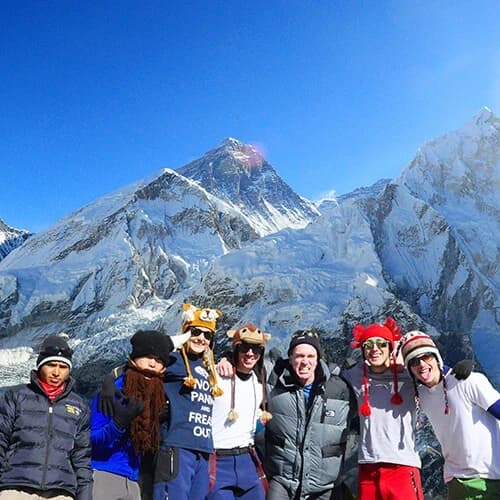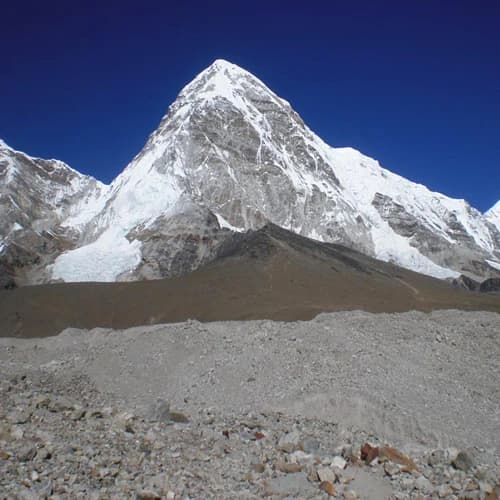Mount Everest is the world's highest summit, representing human aspirations and the awe-inspiring power of nature. The peak rises to 8,848 meters (29,032 feet) above sea level, attracting adventurers and explorers worldwide. Mount Everest is named after George Everest, a former Surveyor General of India. The Mighty Peak has different names in different languages. In Tibetan, it is named Chomolungma, which means "Goddess Mother of the World." Similarly, in Sanskrit, it is called Sagarmatha, meaning "Peak of the Heaven." The first expedition to climb Mount Everest was done in the 1920s by British surveyors, but they failed. The first successful expedition was recorded in 1953 by Edmund Hillary of New Zealand and Tenzing Norgay Sherpa of Nepal.
Where is The Mount Everest located ?
Mount Everest Location
Mount Everest is located between the border of Nepal and Tibet, an area of China. Situated in the Mahalangur Range of the Himalayas, it is pinpointed at 27°59' North latitude and 86°55' East longitude. The survey took place in 2005 and was initiated by the China National Surveying and Mapping Administration. To be precise, Mount Everest is situated in Sagarmatha National Park in Solukhumbu, Nepal, and on the Quig Zang plateau of Tibet. The peak can be summited from both Nepal and China. However, in comparison, the Nepalese route is more accessible.
Everest in Nepal
Located within the Sagarmatha National Park, a UNESCO World Heritage Site in the Solukhumbu District, Mount Everest is one of the best trek destinations in the world. The area around the peak is famous for its natural scenery and unique cultural diversity. The trek to Everest Base Camp takes you through several Sherpa villages alongside rivers, waterfalls, and landscapes, offering a glimpse into the rich local culture and stunning natural landscapes.
Everest in Tibet
In Tibet, Mount Everest lies in the Tingri County of the Xigaze area. Accessing the peak from its northern side is less popular due to strict permit regulations. However, trekking to Mount Everest from Tibet offers unique perspectives on beauty, aesthetics, and glory. The approach also provides a quieter, less commercialized experience of the world's highest peak.
The Height of Mount Everest
The most recent measurement for 2020, agreed upon by both Nepal and China, is 8,848.86 meters (29,032 ft). The height of the mountain varies depending on climatic conditions. Only in recent years, with the advent of the Global Positioning System and satellite technologies, has it become possible to undertake accurate measurements.
Mount Everest Climbing Routes and Trekking
The two main trails to summit Mount Everest are through the southeast ridge from Nepal and the northeast ridge from Tibet. One can take the south route of the Nepal side since it has better logistical access and more developed climbing infrastructure. This route takes mountaineers via the Khumbu Icefall, the Western Cwm, and the South Col before climbing to the summit.
Everest Climbing Routes: North vs. South
The south route via Nepal is the most popular due to its accessibility and established infrastructure. Though less crowded, the northern route via Tibet poses different challenges, like harsher weather and more difficult permits. Depending on preferences and skill levels, these routes offer unique experiences and challenges.
North Everest Climbing Map
- Everest Base Camp at 5,130 m (16,830 ft)
- Intermediate Camp at 5,980 m (19,619 ft)
- Advance Camp at 6,400 m (20,997 ft)
- Camp 1 at 7,300 m (23,950 ft)
- Camp 2 at 7,900 m (26,000 ft)
- Camp 3 at 8,300 m (27,400 ft)
Mount Everest on the Nepal-Side (South Col)
- Everest Base Camp is at an altitude of 5,364 m (17,598 ft)
- Camp 1 at 5,980 m (19,619 ft)
- Camp 2 at 6,400 m (20,997 ft)
- Camp 3 at 7,300 m (23,950 ft)
- Camp 4 at 7,900 m (26,000 ft), gateway to the Death Zone
Trekking to Everest Base Camp
The Everest Base Camp Trek is one the most popular treks in Nepal and the world because of its unbelievable scenic views, close-up experience with the culture, and a sense of pride in personal achievement. The trek starts from Lukla and passes by villages like Phakding, Namche Bazaar, Tengboche, Dingboche, and Lobuche to Base Camp. The journey includes adequate acclimatization for trekkers, allowing their bodies to adapt to the increasing elevation.
Popular Trekking Packages
1. Everest Base Camp Trekking
Everest Base Camp Trek is a 15-day trek to the base of the world's highest mountain. It is a once-in-a-lifetime experience that takes you close to mountain peaks, cultural villages, glaciers, and vivid vegetation. This trip has incredible views of mountains like Mount Everest, Lhotse, Thamserku, and Ama Dablam. This moderate trekking expedition is suitable for all age groups with reasonable fitness levels.
2. Everest 3 High Pass Trekking
Everest The Everest High Pass Trek is a treat for adventurous trekkers who want to enjoy the thrill and natural beauty of the Khumbu region. During this expedition, you will hike to vantage points like Kala Pathhar and Everest Base Camp. Moreover, you will pass through Kongma La Pass (5,535/18,159ft), Cho La Pass (5420m/17,782ft), and Renjo La Pass (5,340m/17,520ft), enjoying an incredible view of snow-capped mountains.
3. Gokyo Valley Renjo Pass Trekking
Gokyo Valley Via Renjo Pass Trek is famous for trekkers who want to discover Nepal's beauty in a limited time. This trek has a short route through the Khumbu region, which passes through dense birch, oak, pine, and rhododendron forests. This offers a perfect opportunity to encounter wild animals like Musk deer, yaks, and Himalayan tahr.
4. Everest Base Camp Luxury Trek
Everest Base Camp Luxury Trek is quite similar to other treks in the region, but the experiences and service you will receive will be different. This trek is full of adventure, including breathtaking views of mountains, rich culture, and dynamic flora and fauna. The trek passes through beautiful Sherpa villages of the Khumbu region, which offer excellent service and accommodation.
5. Everest Base Camp Yoga Trek
Everest Base Camp Yoga Trek offers daily yoga and meditation amidst the breathtaking Himalayan landscapes. The main highlights of the trek include the beautiful Sherpa village of Namche Bazaar, the holy Tengboche Monastery, and the iconic Everest Base Camp. You will experience magical views from Kala Patthar and enjoy the rich culture of the Khumbu region. This trek is a unique opportunity for physical rejuvenation and spiritual growth beside the world's highest mountain.
How much does it cost to climb Mount Everest?
Climbing Mount Everest costs from $50,000 to $75,000, which includes permits, equipment, guides, and logistics. The Nepalese government issues a permit that costs $11,000 per climber. Other expenses include travel, food, insurance, and accidents or coverage that must be availed of with emergency evacuations.
When is the best time to climb Mount Everest?
The best times to climb Mount Everest are the pre-monsoon season, which extends from late April to early June, and the post-monsoon season, which spans from late September to early November. The weather is less volatile in these windows, the winds are lower, and the sky is clear, offering the best conditions for an ascent.
Everest Base Camp Trek Difficulty
The trek to Everest Base Camp is challenging, but with proper preparation, anyone with reasonable fitness can accomplish the expedition. Altitude sickness is a prime risk factor during the trek, which any travelers should be concerned about. To avoid the illness, you must rest well, acclimatize properly, hydrate yourself, and ascend slowly and gradually. Besides, we highly recommend you prepare yourself physically two months before the start of the expedition. Indulge yourself in training exercises in the gym, such as jogging, weight lifting, swimming, cycling, etc.
Vegetation in the Everest Region
The vegetation in the Everest area includes deciduous forests that dominate the lower altitudes and subalpine and alpine vegetation that covers the higher altitudes. Moreover, as you reach the base camp, it changes into a tundra characterized by icy and snowy terrains. This variation makes it an ideal destination for nature lovers and travelers who want to experience the natural beauty of the Himalayas.
People in the Everest Region
The Sherpa community is integral to the Everest region. Sherpas are Skilled mountaineers who will guide you through the tough terrains of the Himalayas. Rich in traditions and festivities, their culture offers a unique cultural dimension in which to immerse yourself. Apart from tourism, the Sherpa people are engaged in agriculture and animal husbandry.
Interesting Facts and Records
- Everest Marathon: The Everest Marathon is the highest marathon in the world. It starts in Namche Bazaar from Everest Base Camp and reenacts the pathway of the first historical ascenders, Sir Edmund Hillary and Tenzing Norgay.
- Rita Sherpa: The record holder for the highest number of summits of Everest, summited the mountain 30 times as of May 2026.
Some Most Popular Treks
- Everest Base Camp Trek - 14 Days
- 12 Days Everest Base Camp Trek
- Everest Base Camp Luxury - 14 Days
- Everest Cho La Pass - 17 Days
- Everest High Pass 16 - Days
- Annapurna Base Camp - 13 Days
- Ghorepani Poon Hill - 7 Days
- Annapurna Circuit - 17 Days
- 12 Days Annapurna Circuit Trek
- Manaslu Circuit - 14 Days
- Manaslu Trek 12 Days
- Everest Base Camp with Island Peak - 16 Days
- Everest Luxury Trek with Helicopter Return
- Langtang Valley - 10 Days




